Woods mushrooms, also known as wild mushrooms, are fungi that grow naturally in forested areas. They come in various species, including both edible and poisonous types. Identifying them correctly is crucial, as some can be highly toxic.
Woods mushrooms, with their mysterious allure, beckon adventurers into the heart of nature’s hidden kingdom. These fungi, sprouting in the damp, shaded undergrowth, offer a tantalizing mix of beauty and danger. Each step through the forest could reveal a culinary treasure or a toxic trap. The thrill of the hunt, paired with the challenge of identification, makes for an exhilarating journey. Foraging for woods mushrooms transforms a simple walk in the woods into a captivating quest filled with wonder and discovery.
Woods mushrooms are a fascinating group of fungi that thrive in forest ecosystems, often forming symbiotic relationships with trees. They come in a diverse array of shapes, colors, and sizes, each with unique characteristics. Many edible varieties, such as chanterelles and morels, are highly prized by foragers and chefs for their rich flavors. However, the woods also harbor poisonous species, like the deadly Amanita, making accurate identification essential. Studying wood mushrooms not only enhances foraging skills but also deepens our understanding of the intricate balance within forest habitats.
Identification and Habitat
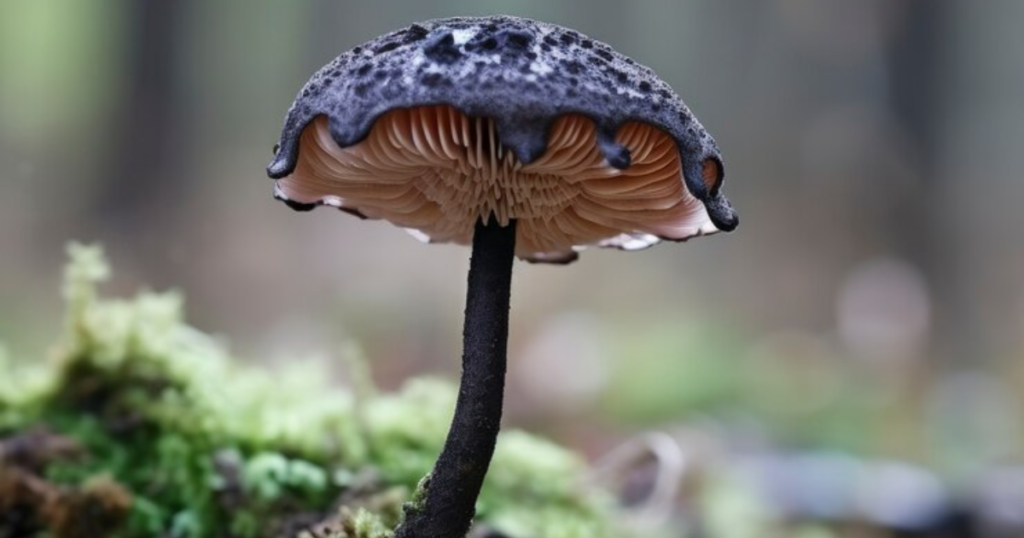
Hen of the Woods mushrooms are relatively easy to identify, making them a favorite among mushroom hunters. They typically grow at the base of oak trees, but they can also be found near other hardwoods such as maple, elm, and chestnut. The mushrooms appear as large clusters, often weighing several pounds, and their fronds resemble the ruffled feathers of a hen, which is how they got their common name.
The caps of Hen of the Woods mushrooms are grayish-brown and fan-shaped, with a wavy, irregular edge. They grow in overlapping layers, giving the cluster a rosette-like appearance. The undersides of the caps are white and covered in tiny pores rather than gills. The stem is thick and branched, anchoring the mushroom firmly to the base of the tree.
Hen of the Woods mushrooms are perennial and typically appear in late summer to early autumn. They are most commonly found in North America, Europe, and Asia, thriving in temperate forests. Foragers often spot them after a period of rain, which stimulates their growth.
Culinary Uses
Hen of the Woods mushrooms are highly valued in the culinary world for their robust, earthy flavor and meaty texture. They can be used in a variety of dishes, from soups and stews to stir-fries and sautés. The mushrooms’ complex flavor pairs well with both meat and vegetarian dishes, making them a versatile ingredient in any kitchen.
One popular way to prepare Hen of the Woods mushrooms is to roast them. Simply toss the mushroom fronds with olive oil, salt, and pepper, and spread them out on a baking sheet. Roast in a preheated oven at 400°F (200°C) for about 20 minutes, or until they are crispy and golden brown. The result is a deliciously savory snack or side dish that highlights the mushroom’s natural umami flavor.
Hen of the Woods mushrooms also make a fantastic addition to pasta dishes. Sauté the mushrooms with garlic, onions, and herbs, then toss them with cooked pasta and a light cream or tomato sauce. The mushrooms’ rich flavor adds depth to the dish, making it a satisfying and comforting meal.
Medicinal Properties
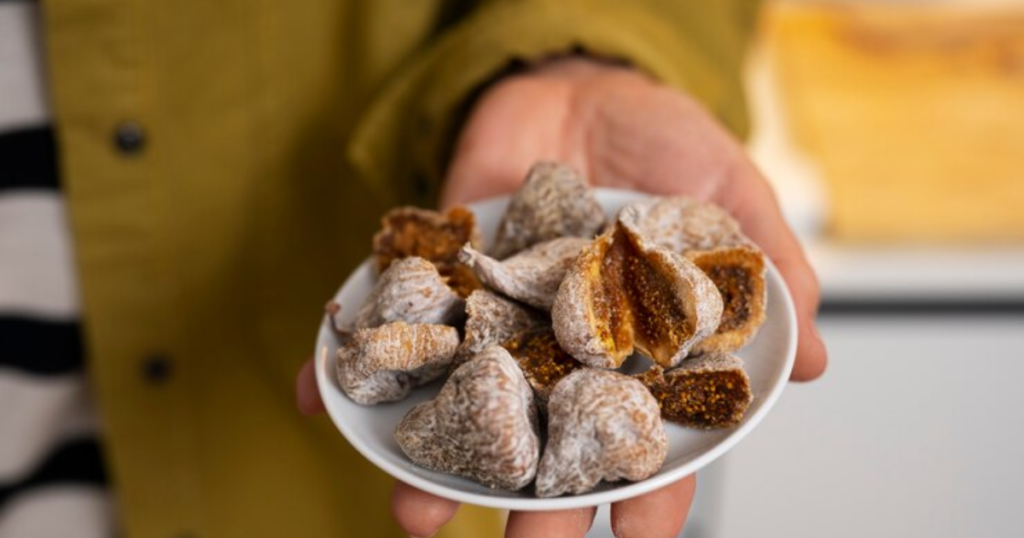
Beyond their culinary appeal, Hen of the Woods mushrooms are celebrated for their medicinal properties. Traditional Chinese and Japanese medicine has long used Maitake as a remedy for various ailments, and modern research supports many of these traditional uses.
One of the most significant health benefits of Hen of the Woods mushrooms is their potential to boost the immune system. They contain beta-glucans, a type of polysaccharide that has been shown to enhance the activity of immune cells, such as macrophages and natural killer cells. This immune-boosting effect can help the body fight off infections and may even have anti-cancer properties.
Studies have also indicated that Hen of the Woods mushrooms may help regulate blood sugar levels. This is particularly beneficial for individuals with diabetes or those at risk of developing the condition. The mushrooms contain compounds that can improve insulin sensitivity and reduce blood glucose levels, making them a valuable dietary addition for managing diabetes.
Foraging for Hen of the Woods Mushrooms
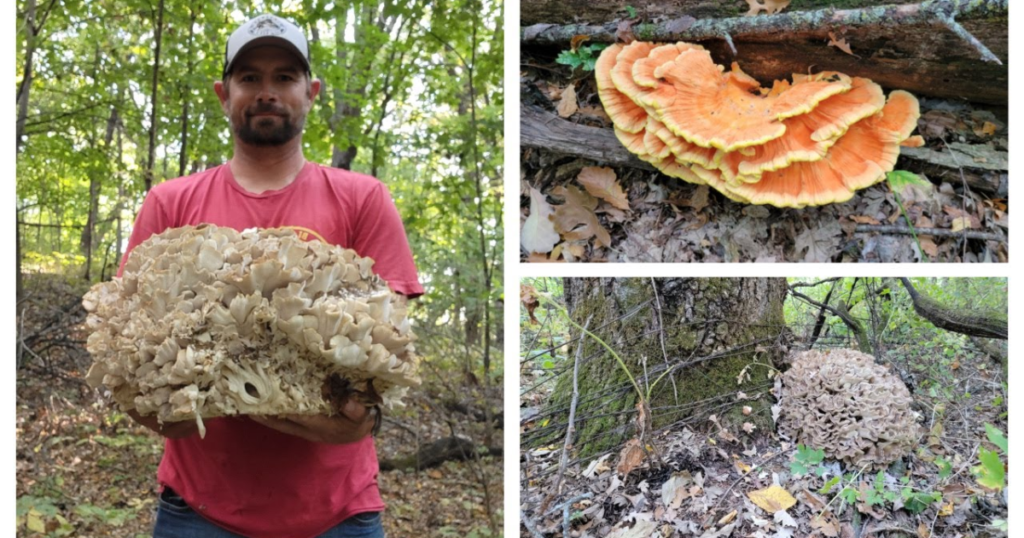
Foraging for Hen of the Woods mushrooms can be a rewarding and enjoyable experience. However, it’s essential to be well-prepared and knowledgeable to ensure a successful and safe harvest. Here are some tips for foraging for Hen of the Woods mushrooms:
Do Your Research
Before heading out, familiarize yourself with the appearance and characteristics of Hen of the Woods mushrooms. Look at pictures and read descriptions to ensure you can accurately identify them in the wild.
Choose the Right Location
Hen of the Woods mushrooms grow at the base of hardwood trees, especially oaks. Visit forests with a high concentration of these trees, and focus on areas with plenty of moisture.
Go at the Right Time
The best time to find Hen of the Woods mushrooms is in late summer to early autumn, after a period of rain. Mushrooms thrive in damp conditions, so plan your foraging trips accordingly.
Bring the Right Tools
Carry a sharp knife or a pair of scissors to harvest the mushrooms cleanly. A basket or mesh bag is ideal for collecting them, as it allows spores to disperse and helps keep the mushrooms fresh.
Check for Lookalikes
While Hen of the Woods mushrooms are distinctive, there are a few lookalikes, such as the Black-Staining Polypore (Meripilus sumstinei). Make sure you can confidently differentiate between these species to avoid any mistakes.
Harvest Responsibly
When harvesting Hen of the Woods mushrooms, leave some behind to ensure the continued growth and reproduction of the species. Avoid damaging the surrounding area and other plants.
Cultivating Hen of the Woods Mushrooms
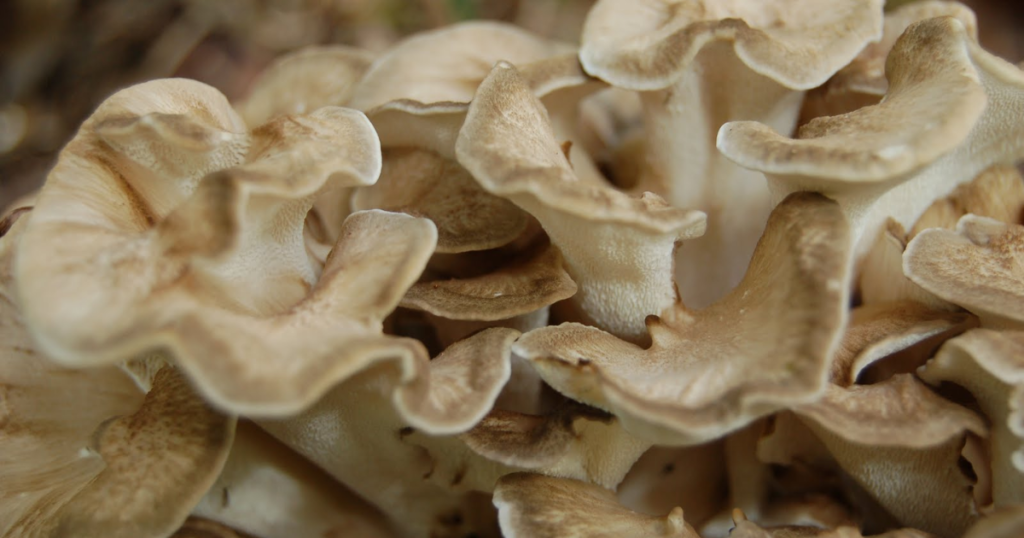
For those who prefer not to forage, cultivating Hen of the Woods mushrooms at home is an excellent alternative. Although growing these mushrooms can be more challenging than other varieties, it is still achievable with the right techniques and patience.
Hen of the Woods mushrooms can be grown on hardwood logs or sawdust blocks. Here are the basic steps for cultivating them:
Obtain Spawn
Purchase Hen of the Woods spawn from a reputable supplier. Spawn is the mycelium, or vegetative part, of the fungus used to inoculate the growing medium.
Prepare the Growing Medium
If using logs, choose fresh hardwood logs, preferably from oak, maple, or beech trees. Drill holes into the logs and insert the spawn. Seal the holes with wax to prevent contamination. For sawdust blocks, mix the spawn with sterilized hardwood sawdust and pack it into growing bags.
Incubate
Place the inoculated logs or sawdust blocks in a shaded, humid environment. Maintain a temperature of around 60-75°F (15-24°C) and ensure adequate airflow. The mycelium will colonize the logs or sawdust over several months.
Fruiting
Once the mycelium has fully colonized the growing medium, it will begin to fruit. This process can take anywhere from six months to a year. Maintain high humidity and monitor the logs or blocks for mushroom growth.
Read More:
Growing Chestnut Mushrooms At Home
Harvest
When the Hen of the Woods mushrooms are mature, cut them at the base of the fronds. Be gentle to avoid damaging the growing medium, as it can produce multiple flushes of mushrooms over time.
Cooking with Hen of the Woods Mushrooms

Once you’ve foraged or cultivated your Hen of the Woods mushrooms, it’s time to enjoy their rich, savory flavor in the kitchen. Here are a few delicious recipes to get you started:
Hen of the Woods Risotto
Ingredients
- 2 cups Hen of the Woods mushrooms, cleaned and chopped
- 1 cup Arborio rice
- 1 small onion, finely chopped
- 2 cloves garlic, minced
- 4 cups vegetable or chicken broth, warmed
- 1/2 cup dry white wine
- 1/2 cup grated Parmesan cheese
- 2 tablespoons olive oil
- 2 tablespoons butter
- Salt and pepper to taste
- Fresh parsley, chopped (optional)
Instructions
- Heat the olive oil in a large skillet over medium heat. Add the onions and garlic, and sauté until softened.
- Add the chopped Hen of the Woods mushrooms and cook until they release their moisture and begin to brown.
- Stir in the Arborio rice, coating it with the oil and mushroom mixture.
- Pour in the white wine and cook, stirring, until it is mostly absorbed.
- Gradually add the warmed broth, one ladle at a time, stirring constantly. Allow each addition of broth to be absorbed before adding the next.
- Continue this process until the rice is creamy and tender, about 18-20 minutes.
- Stir in the butter and Parmesan cheese, and season with salt and pepper to taste.
- Garnish with fresh parsley, if desired, and serve hot.
Hen of the Woods Stir-Fry
Ingredients
- 2 cups Hen of the Woods mushrooms, cleaned and separated into fronds
- 1 red bell pepper, sliced
- 1 small zucchini, sliced
- 1 carrot, julienned
- 3 cloves garlic, minced
- 2 tablespoons soy sauce
- 1 tablespoon oyster sauce
- 1 tablespoon sesame oil
- 2 tablespoons vegetable oil
- Cooked rice or noodles, for serving
- Sesame seeds and green onions, for garnish
Instructions
- Heat the vegetable oil in a large wok or skillet over high heat.
- Add the garlic and cook for a few seconds until fragrant.
- Add the Hen of the Woods mushrooms and stir-fry until they start to brown.
- Add the bell pepper, zucchini, and carrot, and continue to stir-fry until the vegetables are tender-crisp.
- Stir in the soy sauce, oyster sauce, and sesame oil, and cook for another minute to coat the vegetables and mushrooms.
- Serve the stir-fry over cooked rice or noodles, and garnish with sesame seeds and green onions.
FAQs
What is the best time of year to find Hen of the Woods mushrooms?
The best time to find Hen of the Woods mushrooms is from late summer to early autumn, typically after a period of rain when the conditions are damp.
Are Hen of the Woods mushrooms safe to eat?
Yes, Hen of the Woods mushrooms are safe to eat and are highly valued for their rich flavor and numerous health benefits, but always ensure proper identification before consumption.
Can Hen of the Woods mushrooms be cultivated at home?
Yes, Hen of the Woods mushrooms can be cultivated at home on hardwood logs or sawdust blocks, though the process requires patience and specific conditions.
What are the medicinal benefits of Hen of the Woods mushrooms?
Hen of the Woods mushrooms are known for their immune-boosting properties, potential to regulate blood sugar levels, and high antioxidant content.
How should Hen of the Woods mushrooms be stored?
Hen of the Woods mushrooms should be stored in a paper bag in the refrigerator, where they can last for up to a week; they can also be dried or frozen for longer storage.
Conclusion
The Hen of the Woods mushroom is a remarkable and versatile fungus with a rich history in both culinary and medicinal traditions. Whether you’re a seasoned forager, a budding mycologist, or simply a food enthusiast, this mushroom offers something for everyone. Its distinctive appearance, robust flavor, and numerous health benefits make it a valuable addition to any diet.
Foraging for Hen of the Woods mushrooms can be a rewarding experience, connecting you with nature and providing a sense of accomplishment. Cultivating them at home is also a viable option for those who prefer a more controlled environment. Once you’ve harvested these mushrooms, the culinary possibilities are endless, from simple roasts to complex dishes like risotto and stir-fry.

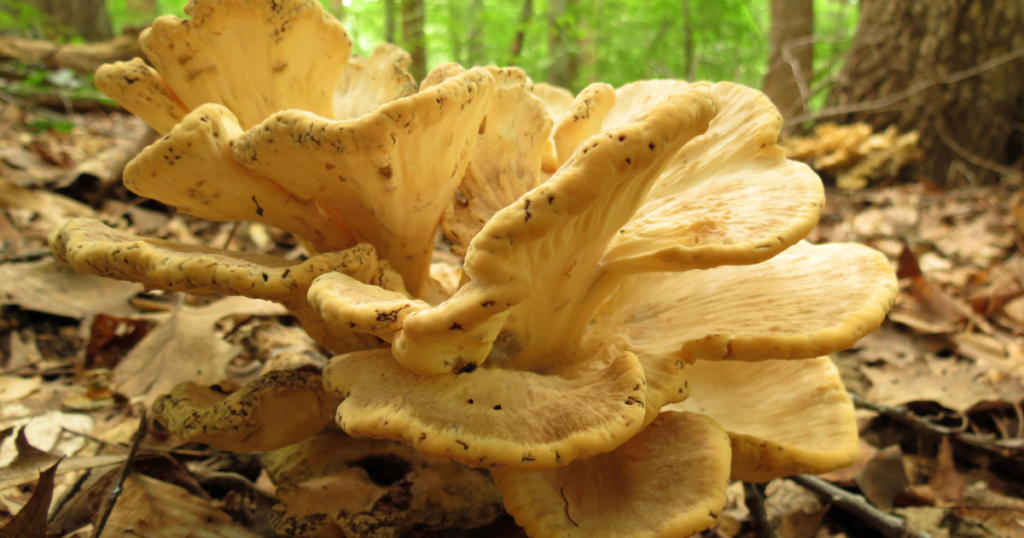
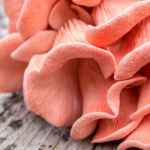
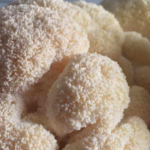
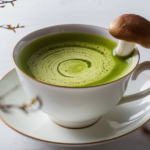
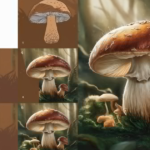


1 thought on “Hen Of The Woods Mushroom”